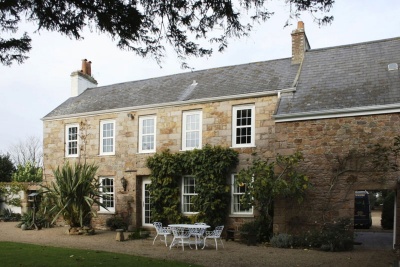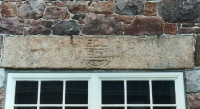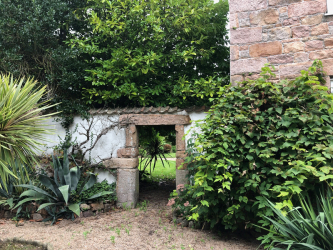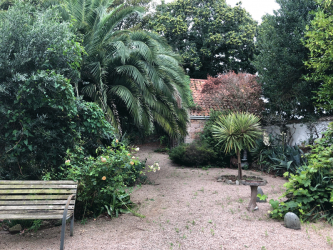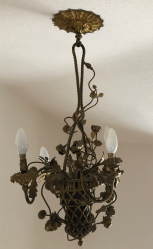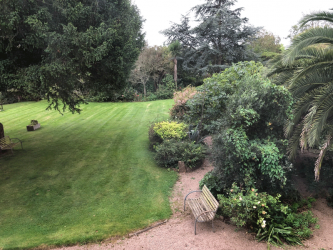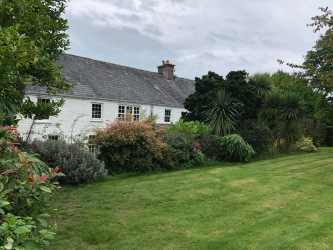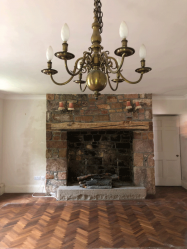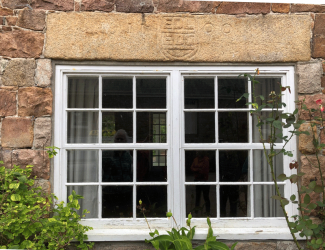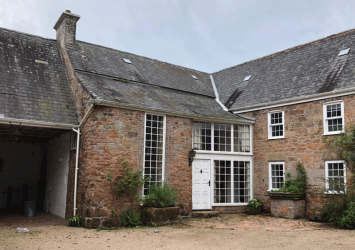Historic Jersey buildings
If you own this property, have ancestors who lived here, or can provide any further information and photographs, please contact us through editorial@jerripedia.org |
Property name
La Chasse
Other names
La Maison des Matthieus [1]
Location
Profonde Rue, Trinity
Type of property
19th century farm group with ancient origins
Valuations
On sale for £4.5 million at the end of 2023
Families associated with the property
- De Gruchy: The original house on this property was, until the mid-16th century, on the site of that now facing south, with the north facade looking onto the "chasse" that gave it in 1847, its name, as attested by the date on the gateposts. The land owned here by the de Gruchys, in the 16th century, was about 70 vergees. Shortly after the death of Robin de Gruchy ca. 1533, his second son Thomas, chose by way of inheritance, land immediately to the west of the "chasse" and built there his own two-storey home, about eight foot away from, and to the north-west of, the main house. From that time, there were, until 1863, two houses, with outbuildings, on the site. That of Thomas de Gruchy remained in the ownership of his male descendants until 1698 when, on the death of Nicolas de Gruchy, it passed to his sister Rachel. She sold it in the same year to her brother-in-law, Edouard de La Lande and Esther de Gruchy, his wife, whose initials "EDL.EDG" and the date 1700, remain on the house. This house was bought by Jean de Gruchy, owner of the main house, in 1863, as was its land, thus reuniting the family property
- De La Lande
- De Gruchy: In the 1901 census farmer John de Gruchy (1834- ) and his daughters Elize (1884- ), Ada (1884- ) and Louisa (1885- ) were living here. John's wife Elizabeth, nee Cabot, had died and John died later in the year, after the census was taken
Although there were a number of families registered at La Chasse, Trinity in 1941, it has not been possible to differentiate between those living here and those at La Chasse, Rue du Hurel
Datestones
- EDL above EDG flanked by 1700 - For Edouard de la Lande and Esther de Gruchy. This is on the former north-west house
- 17 IDL ♥♥ ILG 78 - For Jean de la Lande and Jeanne Le Gros, who married in 1772, also on the former north-west house
- 18 IDGC ♥ JDGC 55 - For Jean and Jeanne de Gruchy, on the main house. Jean had bought from a distant cousin, Philippe de Gruchy, fils Jean, fils Matthieu, the ancient south-eastern, or main, portion of the property in 1847. It was he who reunited in 1863 the land and bought also the north-west house
- 1 IDG 800 - Unusual arrangement, for Jean de Gruchy, the son of Matthieu, above
- ECB - lintel now upside down
Historic Environment Record entry
Listed building
A farm group, 19th century in character, retaining original 19th century features and integrity as a farm group, with evidence of earlier developmental phases. 18th and possible 16th century origins. Shown on the Richmond Map of 1795.
Main farm house (five bays, two storeys) facing south. Dower house (two bays visible) and various outbuildings to the north [2] of the property forming a courtyard, most of which have been converted to residential use. Stables [3] on east side. Single storey outhouse to the west of the main house. [4]
Old Jersey Houses
This property is referred to in Payne's Armorial of Jersey as being on the junction of five fiefs. These were Dielament, Gruchetterie, Saval, Petit Rosel and Vanesse.
In the farmyard are several troughs, one in particular being insteresting as it has an outlet hole and lifting lug. A previous owner thought it had been used for grinding wheat.
History
Also mentioned in Payne's Armorial of Jersey is that the Jersey branch of the de Gruchy family "settled in Trinity...in the latter part of the twelfth, or commencement of the thirteenth century, where it acquired considerable landed property, and gave its name to the fiefs De Grochy and De Gruchetterie. This last is now possessed by the Seigneur of Rozel, who holds the court of the fief in the house pointed out as the original residence of the family" This, the former seigneurial house of the Fief de Gruchetterie, is La Chasse, so named, as above, in 1847. The main house had passed from father to son in the senior line of the family, from the earliest times until 1847, when it was sold to a cousin, who had been the vendor`s brother-in-law.
An article by the medieval historian, G F B de Gruchy, in ABSJ, IX, 18-44, entitled The Entries Relating To Jersey in The Great Rolls of the Exchequer of Normandy of A.D. 1180 reveals that Jersey, in 1180, was divided into three fiscal and administrative districts called "ministeria." That of the central four parishes of St Helier, St Lawrence, St John and Trinity, being called, in Latin, the "Ministerium de Groceio." De Groceio is the standard and regular Latin word used in medieval deeds for de Grouchy or de Gruchy. A reference discovered by the author`s father, Jurat W. L. de Gruchy, who was assisting in the research, refered to "Hugo de Groceio, Minister, Domini Regis," in Jersey, A.D. 1089, who will have been an early minister, presumably of the ministerium bearing his name. The Assize Rolls of 1309, 264, show that the tenants of the Fief de Gruchy, in Trinity, had to provide a house on the fief to hold the prisoners of these self-same four central parishes. The Jersey genealogist, the Revd. J. A. Messervy, in his Généalogie de la Famille de Gruchy, (1920), concluded that Hugh de Grouchy will have held office, while holding the Fief de Gruchy. By 1515, that fief bore signs of having been divided, probably in the years immediately preceding 1309, into that of Gruchy and Gruchetterie, the family`s ancient seat having become the venue for the latter fief`s court, held by later seigneurs, those of Rozel. That venue is the property now called La Chasse.
Regrettably, the old house was found to be very impractical, resulting in the new de Gruchy owners demolishing large sections of it in the late-19th century, replacing them with the rather more commonplace structure now occupying the site. Features that were lost included a round arch, bearing de Gruchy arms, that the celebrated French Marshal de Grouchy was shown in 1836, on his first visit to the Island. There is the footprint of a former tourelle on the side facing the courtyard and a garden gate near the abovementioned bakehouse has re-used chamferred side stones which, from their weathered appearance, would have seen several centuries` use in their previous location.
There are two wells on the site. One of these is exactly below the supporting wall of the house, at the spot where the eight foot gap had been, between the Maison des Matthieus, as the old house was called, and that of 16th century Thomas de Gruchy. It could be accessed from either outside the house or from within, a practical, if damp, arrangement.
The second well was that of the former Thomas de Gruchy/De La Lande part of the property. This is actually under the house, at about the point that dwelling house met outhouse.
A possible third well may have been in fact an abreuvoir, for the benefit of cattle grazing in the field to the south of the main house. It has been a ruin and out of use for many years. The property`s `chatelaine` until recently, the most helpful Mrs Cornall, told the writer of these notes that there is even a spring that appears in the farmyard in wet weather, the usual spring being in the meadow to the north-east, between the stables and the main road. From this site, whether farmyard or meadow, flows one of the tributary streams supplying water to Grands Vaux.
Notes and references
- ↑ After the much-used Christian name of the senior line of Jersey de Gruchys, whose property this was
- ↑ To the north, in fact north-west, of the main house, and since 1863 forming an integral part of it, is the former de La Lande house. Adjoining that, being an extension of that house, extending directly north, was that property`s outhouse, this being a far from unusual Jersey arrangement. Almost enclosing the courtyard, extending east at a right angle from the north-west house, is an actual outhouse
- ↑ Formerly cowsheds
- ↑ This is a bakehouse, complete with its oven in situ, estimated by McCormack, to date from the 17th century. Ashes were cleared from a chute on the outside of the bakehouse`s north wall
